Your family recipes can thrive in solar cooking with the right timing and ingredients. You'll want to cook between 11:00 am and 3:00 pm when the sun is strongest, with clear skies and proper UV exposure. Choose moisture-rich ingredients like tomatoes, onions, and chicken that work well in slow-cooking conditions. Keep your family involved by creating a flexible meal plan that accounts for weather and schedules. Adjust traditional recipes by using herbs de provence and seasonal produce to enhance flavors during the extended cooking time. Track temperatures carefully and rotate your solar oven every 30-45 minutes. The journey to perfect sun-based meals brings both sustainable benefits and delicious results.
Sunlight and Recipe Adjustments
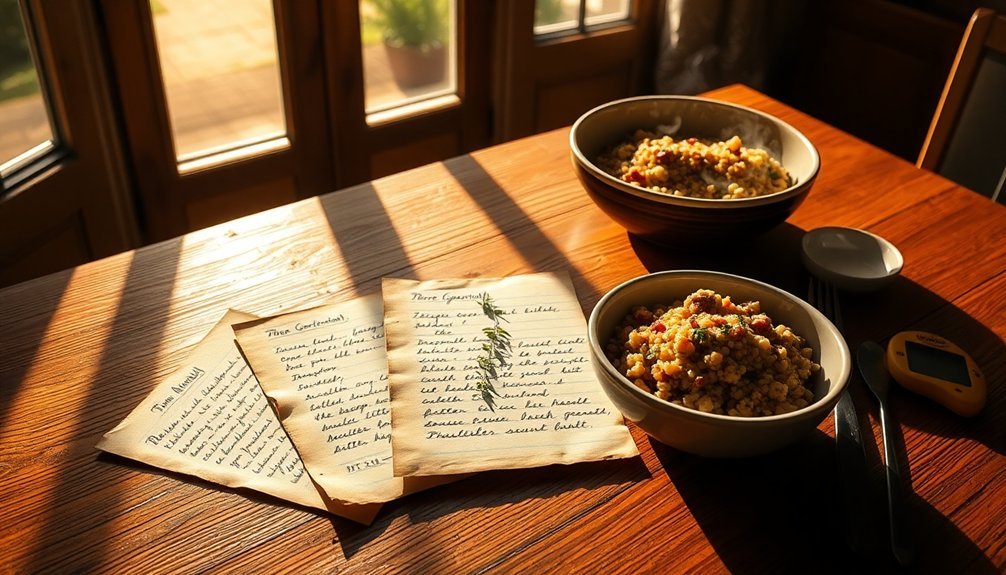
Before diving into solar cooking recipes, understanding the sun's best conditions is essential for success. You'll need a clear sky and sun positioned at least 45 degrees above the horizon. A quick test: if your shadow is shorter than your height, you're good to go.
Look for a UV index of seven or higher for maximum results. Testing in cities like Boston showed significant challenges with UV exposure and sun conditions.
When planning your recipes, you'll need to adjust cooking times based on solar conditions. Keep food safety in mind by ensuring temperatures don't hover between 40 and 140 degrees for over two hours.
Since solar cooking uses minimal water, modify your recipes accordingly. Use an oven thermometer to monitor temperatures and choose dishes suited for slow cooking, like stews and lentils.
Remember to refocus your cooker periodically to maintain steady temperatures throughout the cooking process.
Solar Oven Time Management
Making the most of your solar oven starts with understanding the best hours for cooking.
You'll want to focus on the peak hours between 11:00 am and 3:00 pm when the sun's position is ideal. Using a thermal storage basket can help maintain cooking temperatures when sunlight diminishes. Consider pre-heating your oven at 10:00 am to get a head start on your meal preparation.
To achieve the best results, you'll need to adjust your oven every 30 to 45 minutes to track the sun's movement.
Keep an eye on your food's internal temperature with a thermometer, and avoid opening the lid too frequently. By maintaining consistent adjustments, you can reduce cooking times to match conventional oven speeds.
If you're planning slow-cooker style recipes, expect 4 to 6 hours of cooking time.
Best Ingredients for Solar Cooking

Success in solar cooking depends on choosing ingredients that perform well under gentle, sustained heat. You'll find that certain vegetables, proteins, and grains consistently deliver excellent results in your solar cooker.
For the best solar cooking experience, focus on these ingredient combinations:
- Tomatoes, onions, and peppers work beautifully in Basque chicken and stews.
- Chicken breast and fish retain moisture while absorbing flavors from herbs and spices.
- Eggs transform into perfect frittatas when combined with vegetables and cheese.
- Flour-based dishes like quiche and lasagne turn out wonderfully with ricotta and shredded cheese.
- Aromatics like herbs de provence and bouquet garni infuse deep flavors during slow cooking.
These ingredients shine in solar cooking because they benefit from gradual heat distribution and maintain their nutritional value. The 3-4 hour cooking time allows flavors to develop fully while preserving the texture of vegetables and meats.
Family Meal Planning Essentials
With your solar cooking ingredients ready, let's focus on organizing your family's meals effectively.
Start by creating a master list of recipes your family enjoys, including both solar-friendly dishes and conventional meals. You'll want to involve everyone in the planning process to guarantee their preferences are considered. Having printed recipe copies readily available in your kitchen will help streamline your meal preparation.
Consider your family's schedule when planning solar meals, as timing is vital for sun-based cooking. You'll need clear days and proper preparation windows, so keep your plan flexible.
Maintain an organized grocery list specifically for solar recipes, and inventory your pantry regularly to avoid running short on essential ingredients.
Mix traditional favorites with new solar recipes to keep meals interesting.
Don't forget to post your weekly menu where everyone can see it, and adjust your plans based on weather forecasts and family activities.
Temperature Control and Monitoring

Proper temperature control stands at the heart of successful solar cooking. You'll need to monitor your solar oven's heat distribution and track real-time data to guarantee your family meals turn out perfectly.
Modern apps and sensors make it easier than ever to maintain prime cooking temperatures and receive alerts when adjustments are needed.
To master temperature control in your solar oven, focus on these key aspects:
- Use buffered probe sensors to get accurate readings of food temperature
- Monitor heat distribution zones to identify hot and cold spots
- Track solar position every 5-15 minutes for peak oven placement
- Set up mobile alerts for necessary temperature adjustments
- Record heat retention rates when weather conditions change
Kid-Friendly Solar Meal Ideas
Now that you've mastered temperature control, let's put your solar oven to work with recipes that'll get the whole family excited. Start with simple, quick-cooking dishes like an open-faced omelet that's ready in just 35 minutes. Your kids will love helping you add their favorite vegetables and cheese to create personalized breakfasts.
Turn cooking into a fun learning experience by making s'mores or cherry dump cake together. These desserts aren't just delicious – they'll teach your children about solar energy while they help assemble ingredients.
You can also involve them in preparing solar lasagna or breakfast frittatas, which offer plenty of opportunities for ingredient substitutions. The best part? These recipes use common ingredients you likely already have, making solar cooking both educational and practical for everyday family meals.
Seasonal Recipe Adaptations
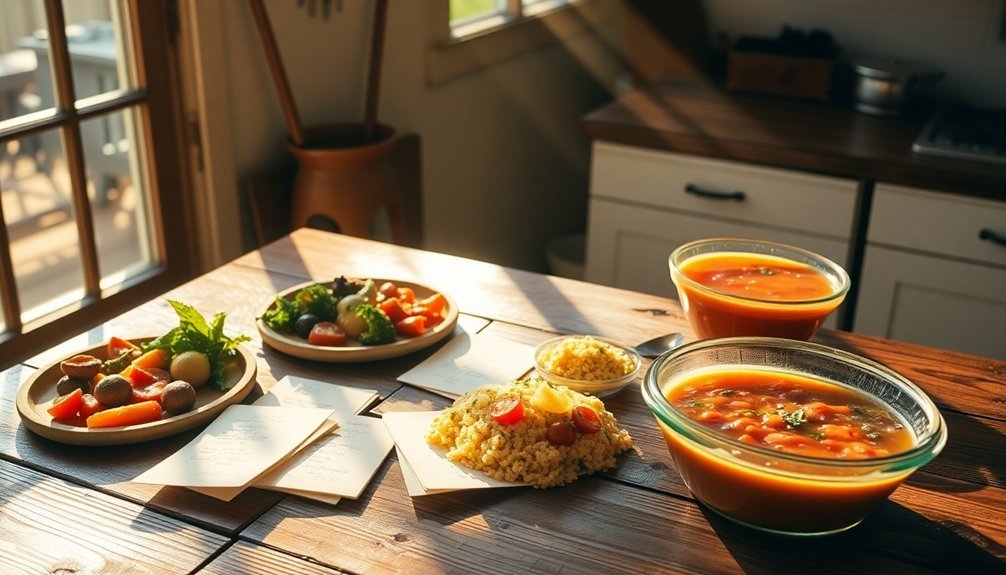
As you shift from summer to fall cooking, you'll find that swapping tomatoes and zucchini for beets and root vegetables keeps your solar-based meals vibrant and nutritious.
Your winter adaptations can transform light summer salads into hearty stews by incorporating seasonal ingredients like winter squash and citrus fruits.
You can maintain your family's favorite recipes year-round by making simple seasonal ingredient substitutions while keeping the core cooking methods intact.
Summer to Fall Shifts
When late summer begins fading into fall, you'll find a unique opportunity to blend the best of both seasons in your kitchen.
You can combine juicy tomatoes and sweet corn with early apples and squash to create versatile dishes that celebrate this shifting period.
Transform your cooking approach with these seasonal shifts:
- Mix grilled corn and fresh apples in salads with maple syrup dressing
- Bake peach and blackberry crumbles topped with warm, buttery streusel
- Incorporate both cherry tomatoes and roasted sunflower seeds in hearty salads
- Use apple cider vinegar to bridge summer-fall flavor profiles
- Adapt your base recipes with whatever produce is available at farmers' markets
This flexible approach lets you maintain consistent techniques while experimenting with seasonal ingredients, keeping your family meals fresh and exciting throughout the change.
Winter Ingredient Swaps
Moving from late summer's abundance into winter's hearty offerings, you'll need a different set of ingredient strategies to keep your family meals vibrant and satisfying.
You can easily adapt your proteins by swapping ground meat for tofu or trying warming dishes like turkey biscuit stew. When it comes to dairy, you've got flexibility – make your own buttermilk with lemon juice, or use plant-based alternatives in creamy soups.
Root vegetables become your best friends during winter months, working perfectly in hearty stews and roasts.
Don't forget about frozen vegetables, which maintain their nutritional value while providing convenience. For grains and pantry items, you can substitute brown rice in stuffed peppers or stock up on versatile canned goods.
These swaps guarantee your sun-inspired family recipes stay delicious year-round.
Sustainable Cooking Benefits
You'll find remarkable cost savings by harnessing the sun's natural energy for your cooking needs.
Solar cooking creates zero waste while eliminating traditional energy expenses, making it an environmentally conscious choice for your family meals.
The sustainable benefits extend beyond your wallet, as you'll reduce your carbon footprint while preserving natural resources for future generations.
Zero-Waste Solar Power
As sustainable living becomes increasingly essential, solar cooking emerges as a powerful solution for zero-waste meal preparation. You'll find that switching to solar cooking dramatically reduces your environmental footprint while keeping your kitchen waste-free.
By eliminating the need for traditional fuel sources, you're contributing to a cleaner planet.
Here's how solar cooking supports zero-waste living:
- No fuel containers or packaging to dispose of
- Uses renewable energy that's completely free
- Creates zero chemical byproducts during cooking
- Requires minimal cleaning supplies for maintenance
- Often utilizes recycled materials in cooker construction
When you adopt solar cooking, you're not just preparing meals – you're participating in a sustainable revolution.
The absence of fuel consumption, combined with durable equipment and clean cooking methods, makes solar cooking an ideal choice for environmentally conscious families.
Natural Energy Cost Savings
While traditional cooking methods can strain your utility bills, smart energy-saving techniques can considerably reduce both costs and environmental impact.
You'll maximize efficiency by choosing Energy Star appliances and opting for smaller devices like slow cookers, pressure cookers, and microwaves that use up to 80% less energy than conventional ovens.
Make simple adjustments to your cooking routine by keeping lids on pots, using the right-sized burners, and turning off heat early to utilize residual warmth.
You'll save more by batch cooking meals ahead of time and reheating them in the microwave.
When using your oven, maximize each session by cooking multiple dishes at once, and avoid opening the door frequently.
Consider using glass bakeware to reduce temperature requirements by 25°F, further cutting your energy consumption.
Safety in Solar Food Preparation
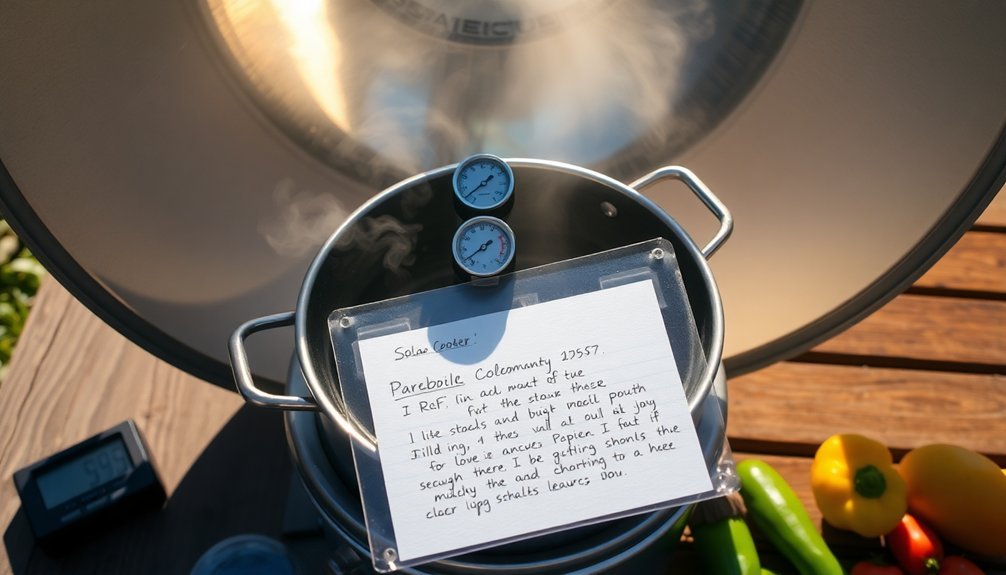
When preparing meals with solar cooking methods, safety must be your top priority to prevent foodborne illness and injuries. Keep food temperatures above 145°F or below 40°F to avoid bacterial growth in the danger zone. You'll need a reliable food thermometer to monitor internal temperatures, especially for meats and poultry.
- Never leave cooked food overnight in an unheated solar cooker unless it's cooled below 50°F.
- Use protective gear like oven mitts and eye protection when handling hot cookers.
- Place your cooker in an unshaded spot between 10 a.m. and 4 p.m. for ideal cooking.
- Store raw ingredients safely, keeping them cold until the sun heats the cooker.
- Clean and sanitize your cooker regularly to prevent cross-contamination.
Remember to cover food during cooking and avoid leaving partially cooked items sitting out, as they can spoil quickly.
Frequently Asked Questions
Can Solar Ovens Be Used Effectively for Baking Bread and Desserts?
Yes, you'll find solar ovens effective for baking bread and desserts when they reach 250-350°F. You can achieve conventional-oven results by monitoring temperature, using dark pans, and allowing proper cooking time.
How Do Cloudy Days Affect the Nutritional Value of Solar-Cooked Foods?
You won't lose nutrients due to cloudy days when solar cooking. While clouds may extend cooking times, the slow, gentle cooking process actually helps preserve vitamins and minerals in your food, regardless of weather conditions.
What Backup Cooking Methods Should Families Have During Unexpected Weather Changes?
You'll need multiple backup options: a propane grill for quick meals, charcoal grill for longer cooking sessions, and a wood-fired stove. Don't forget manual kitchen tools and proper fuel storage for each method.
Are There Special Cleaning Requirements for Solar Cooking Equipment?
You'll need to clean your solar cooker right after use with hot, soapy water or vinegar solution. Don't use abrasives, and regularly clean reflective surfaces. Keep the lid's polyester film clean and well-maintained.
Can Solar Cooking Help Reduce Indoor Heat During Summer Months?
Yes, you'll considerably reduce indoor heat since solar cooking happens entirely outdoors. You won't need your kitchen stove or oven, which means there's no extra heat being generated inside your home during summer.
In Summary
You'll find that family recipes work best for sun-based meals when you adapt cooking times, choose ingredients wisely, and plan ahead. Focus on dishes that can handle variable temperatures and longer cooking periods. Remember to involve your kids in the process, adjust seasonally, and always prioritize food safety. With these considerations, you'll transform traditional family favorites into sustainable solar-powered meals everyone can enjoy.



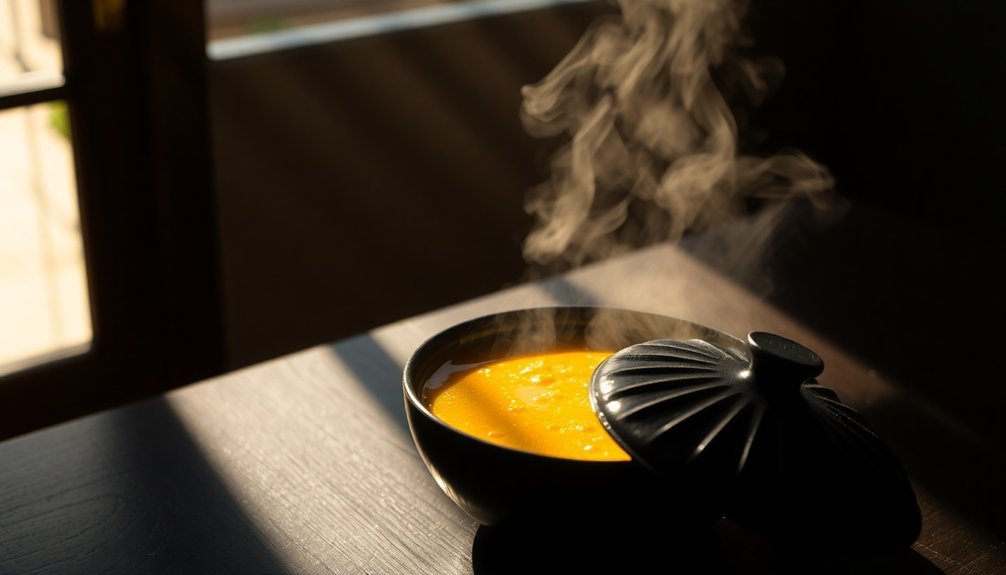
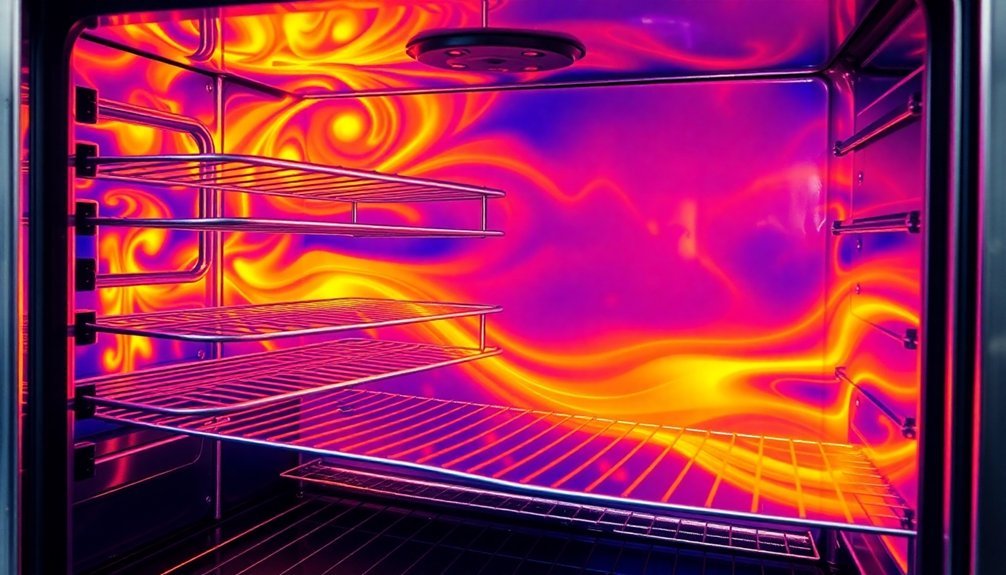
Leave a Reply